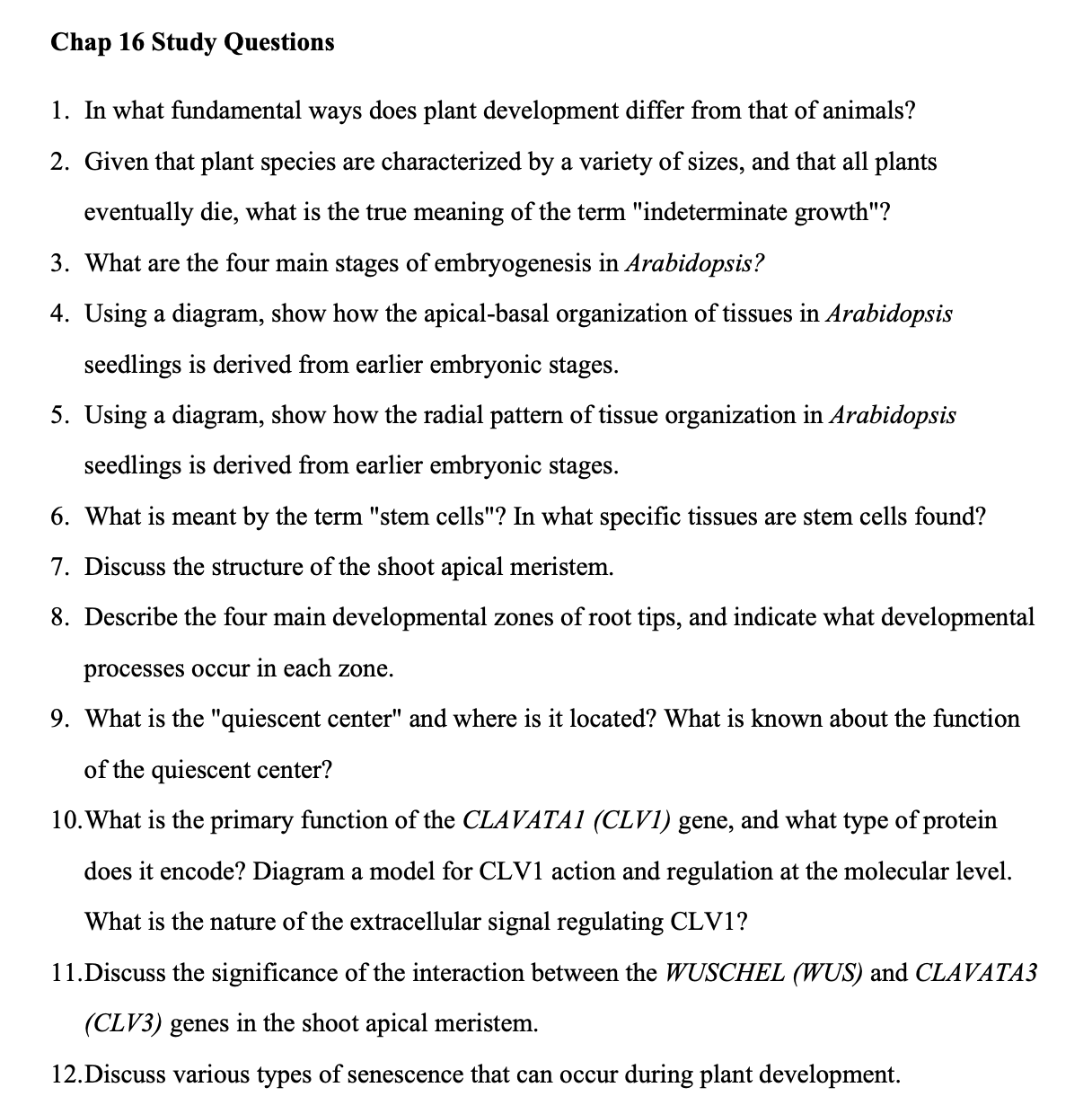


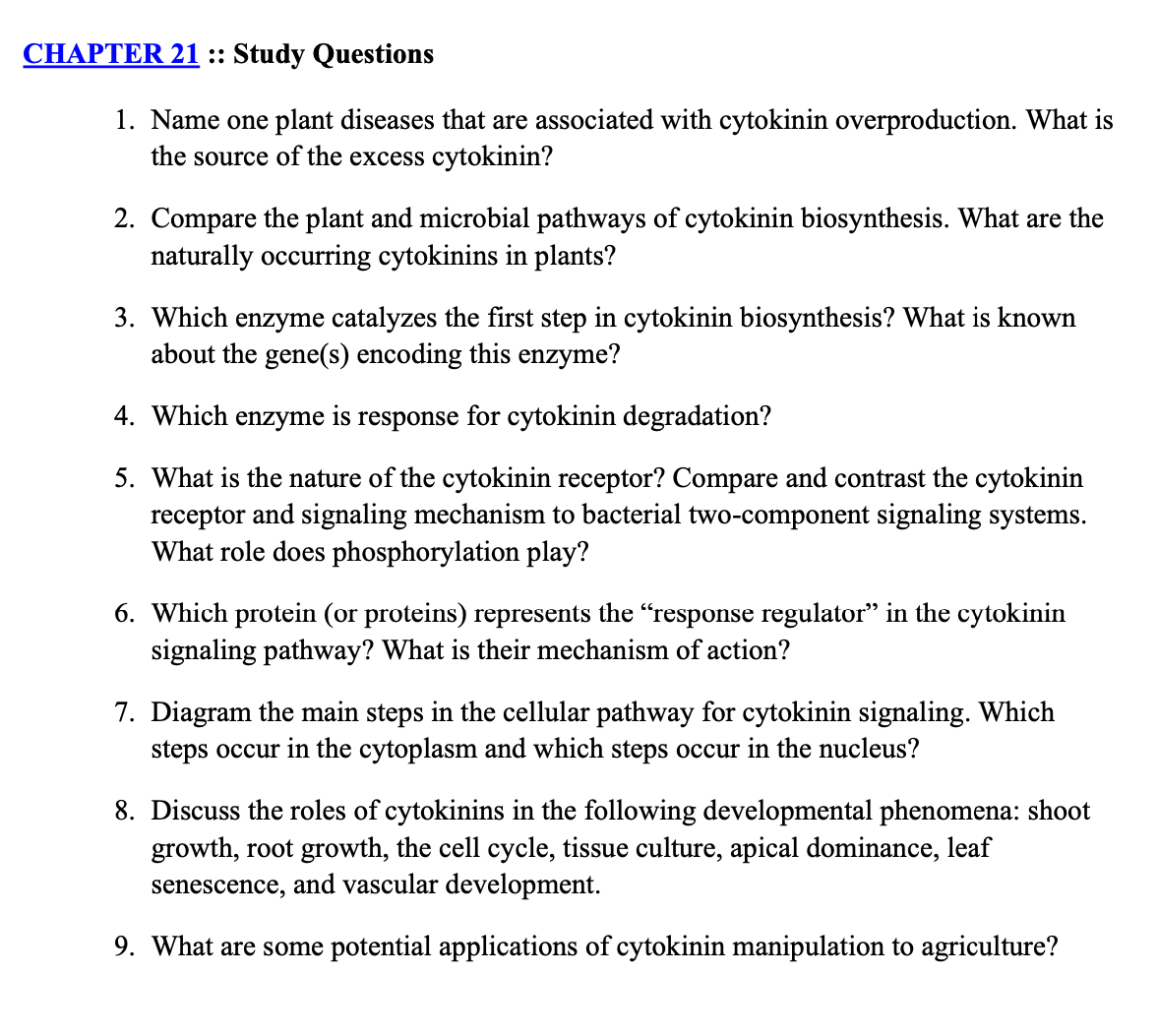
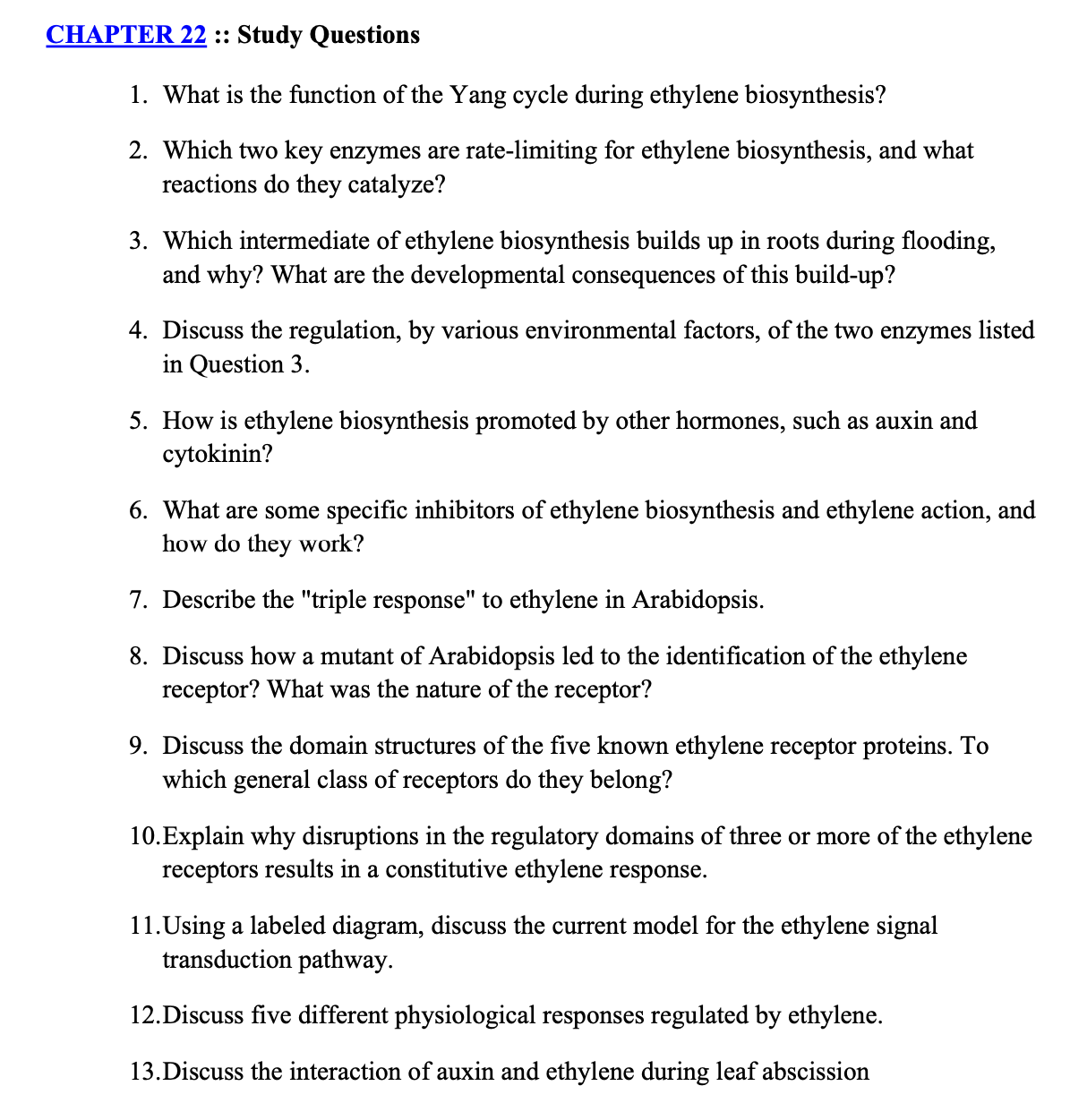
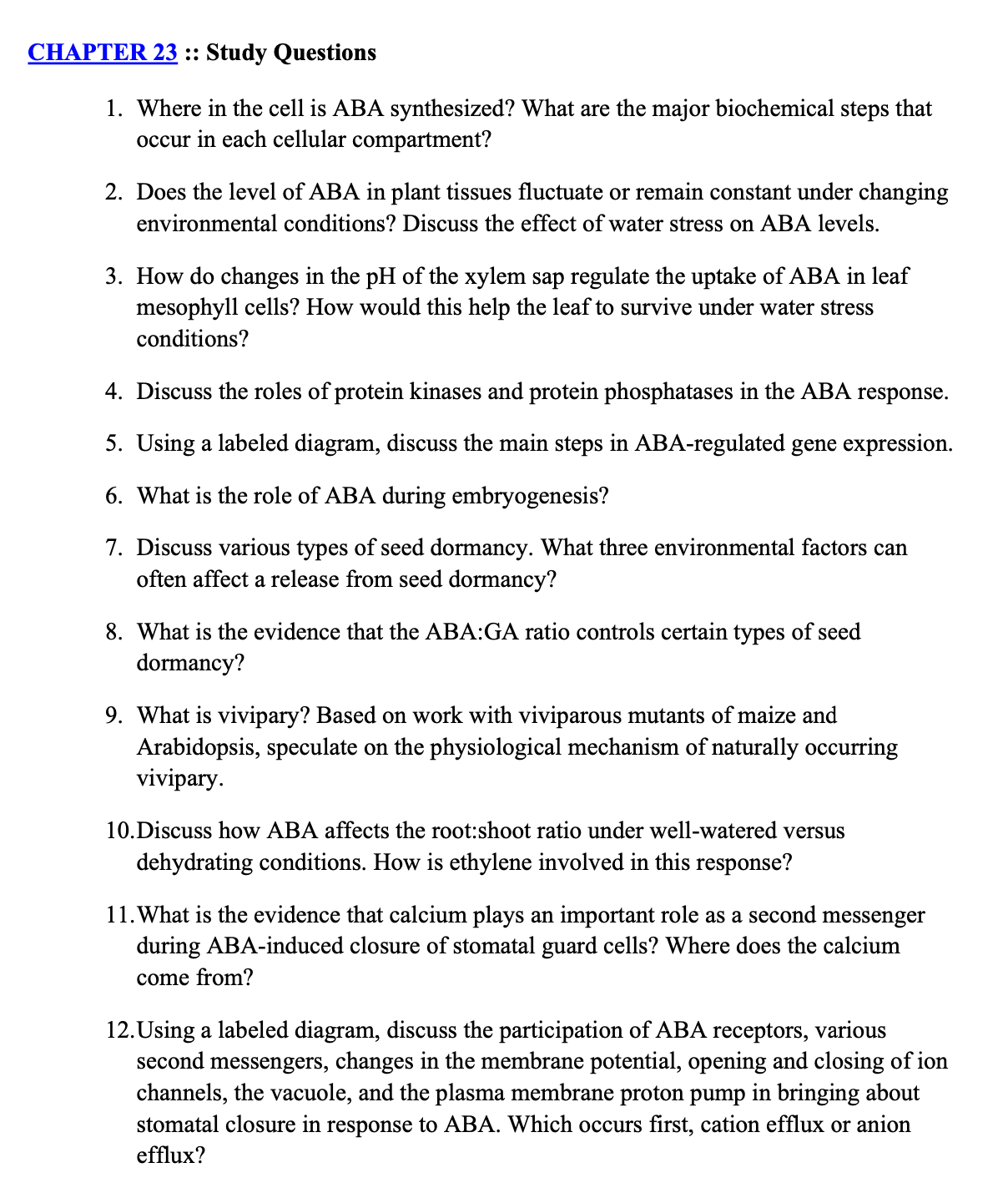
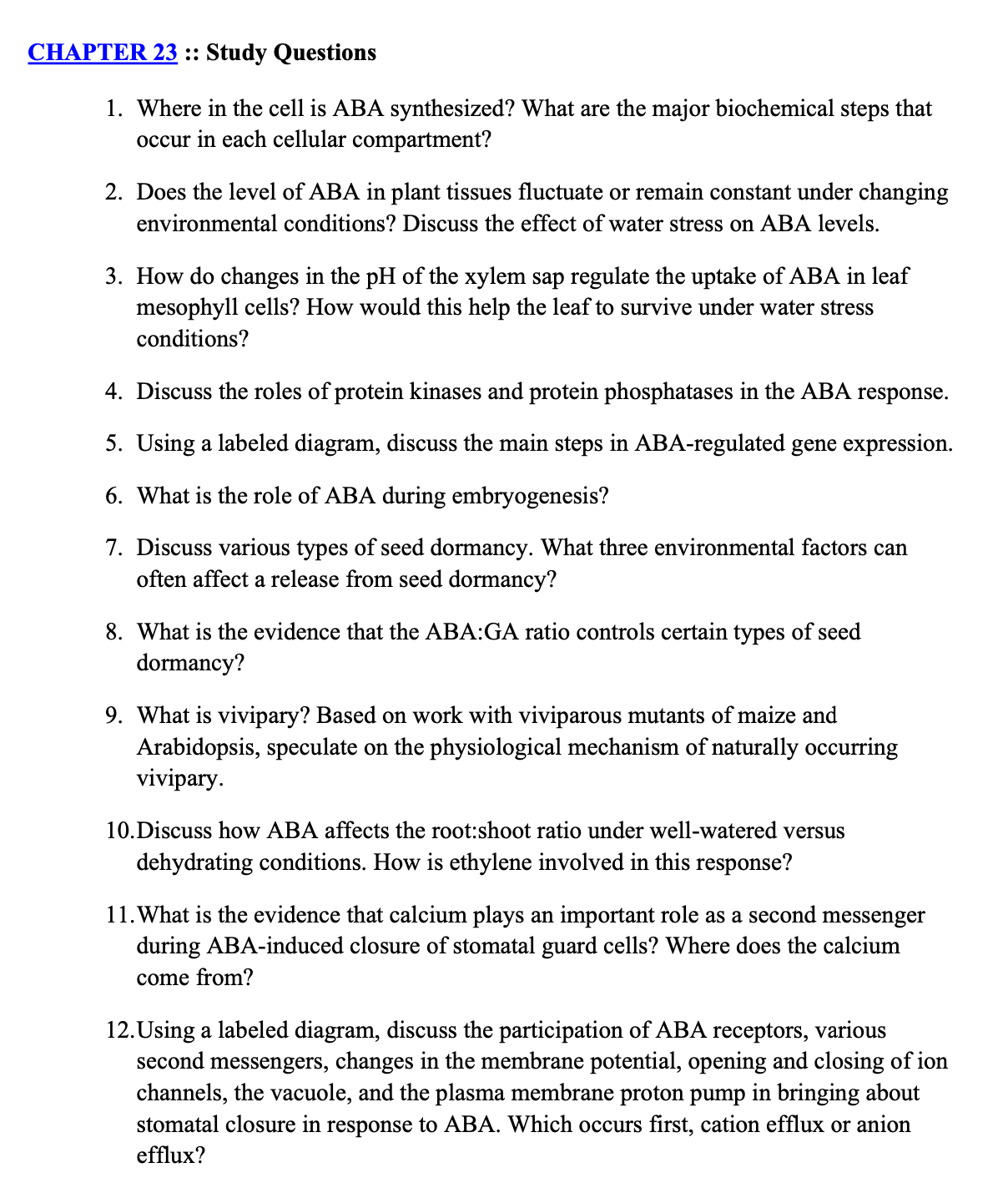

Chap 16 Study Questions 1. In what fundamental ways does plant development differ from that of animals? 2. Given that plant species are characterized by a variety of sizes, and that all plants eventually die, what is the true meaning of the term "indeterminate growth"? 3. What are the four main stages of embryogenesis in Arabidopsis? 4. Using a diagram, show how the apical-basal organization of tissues in Arabidopsis seedlings is derived from earlier embryonic stages. 5. Using a diagram, show how the radial pattern of tissue organization in Arabidopsis seedlings is derived from earlier embryonic stages. 6. What is meant by the term "stem cells"? In what specific tissues are stem cells found? 7. Discuss the structure of the shoot apical meristem. 8. Describe the four main developmental zones of root tips, and indicate what developmental processes occur in each zone. 9. What is the "quiescent center" and where is it located? What is known about the function of the quiescent center? 10. What is the primary function of the CLAVATAI (CLV1) gene, and what type of protein does it encode? Diagram a model for CLV1 action and regulation at the molecular level. What is the nature of the extracellular signal regulating CLV1? 11.Discuss the significance of the interaction between the WUSCHEL (WUS) and CLAVATA3 (CLV3) genes in the shoot apical meristem. 12.Discuss various types of senescence that can occur during plant development.
CHAPTER 19 :: Study Questions 1. What is a bioassay and how did bioassays lead to the discovery of auxin? 2. What is the primary precursor for auxin biosynthesis? 3. How are free auxin levels regulated by conjugation and oxidation? 4. What is meant by the “polar transport” of auxin? How is it measured? What physiological processes are affected by polar transport? 5. Discuss the roles of PIN proteins, ABCB transporters, and AUX/LAX carriers as auxin transporters mediating polar transport. 6. How are auxin transport proteins secreted to the plasma membrane? 7. What is the nature of the auxin receptor? 8. How does auxin's binding to its receptor lead to gene expression? 9. Draw a typical dose-response curve for auxin-induced stem or coleoptile elongation. What happens at high doses? 10.Describe the acid growth hypothesis of auxin action. What is the evidence that supports it? 11. Define and give examples of “tropisms” in plants. 12. What structure or structures act as gravity receptors in plant cells? Where are these structures located in roots? 13.Discuss the cellular pathways and molecular mechanisms of auxin movement in root tips during gravitropism. Which components of the pathway seem to be able to respond to gravity? 14.Discuss how auxin regulates the following developmental phenomena: apical dominance, lateral and adventitious roots, leaf abscission, floral bud development, vascular differentiation, and fruit development.
CHAPTER 20 :: Study Questions 1. What are the common chemical features of gibberellins, and to which general class of compounds are they related? Are all gibberellins biologically active? 2. Briefly describe seven different physiological responses to GA. 3. What are some commercial applications of GA in agriculture? 4. Which pathway produces the early intermediates for GA biosynthesis? What three cellular compartments are involved in gibberellin biosynthesis, and what are the major biochemical steps in each compartment? 5. How can plant height be altered through genetic engineering? 6. What are the three main classes of gibberellin response mutants, and how do they differ from mutants blocked in GA biosynthesis? 7. What effect does GA-binding have on the GID1 receptor? 8. What is the role of DELLA proteins in the GA response? How does GA-binding to its receptor affect DELLA proteins? Describe the series of steps following GA-binding that leads to the GA response. 9. How do cereal aleurone layers respond to GA, and what role does this response play in germination? 10.What is the role of the GAMYB protein in the response of barley aleurone layers to GA?
CHAPTER 21 :: Study Questions 1. Name one plant diseases that are associated with cytokinin overproduction. What is the source of the excess cytokinin? 2. Compare the plant and microbial pathways of cytokinin biosynthesis. What are the naturally occurring cytokinins in plants? 3. Which enzyme catalyzes the first step in cytokinin biosynthesis? What is known about the gene(s) encoding this enzyme? 4. Which enzyme is response for cytokinin degradation? 5. What is the nature of the cytokinin receptor? Compare and contrast the cytokinin receptor and signaling mechanism to bacterial two-component signaling systems. What role does phosphorylation play? 6. Which protein (or proteins) represents the “response regulator" in the cytokinin signaling pathway? What is their mechanism of action? 7. Diagram the main steps in the cellular pathway for cytokinin signaling. Which steps occur in the cytoplasm and which steps occur in the nucleus? 8. Discuss the roles of cytokinins in the following developmental phenomena: shoot growth, root growth, the cell cycle, tissue culture, apical dominance, leaf senescence, and vascular development. 9. What are some potential applications of cytokinin manipulation to agriculture?
CHAPTER 22 :: Study Questions 1. What is the function of the Yang cycle during ethylene biosynthesis? 2. Which two key enzymes are rate-limiting for ethylene biosynthesis, and what reactions do they catalyze? 3. Which intermediate of ethylene biosynthesis builds up in roots during flooding, and why? What are the developmental consequences of this build-up? 4. Discuss the regulation, by various environmental factors, of the two enzymes listed in Question 3. 5. How is ethylene biosynthesis promoted by other hormones, such as auxin and cytokinin? 6. What are some specific inhibitors of ethylene biosynthesis and ethylene action, and how do they work? 7. Describe the "triple response" to ethylene in Arabidopsis. 8. Discuss how a mutant of Arabidopsis led to the identification of the ethylene receptor? What was the nature of the receptor? 9. Discuss the domain structures of the five known ethylene receptor proteins. To which general class of receptors do they belong? 10.Explain why disruptions in the regulatory domains of three or more of the ethylene receptors results in a constitutive ethylene response. 11. Using a labeled diagram, discuss the current model for the ethylene signal transduction pathway. 12.Discuss five different physiological responses regulated by ethylene. 13.Discuss the interaction of auxin and ethylene during leaf abscission
CHAPTER 23 :: Study Questions 1. Where in the cell is ABA synthesized? What are the major biochemical steps that occur in each cellular compartment? 2. Does the level of ABA in plant tissues fluctuate or remain constant under changing environmental conditions? Discuss the effect of water stress on ABA levels. 3. How do changes in the pH of the xylem sap regulate the uptake of ABA in leaf mesophyll cells? How would this help the leaf to survive under water stress conditions? 4. Discuss the roles of protein kinases and protein phosphatases in the ABA response. 5. Using a labeled diagram, discuss the main steps in ABA-regulated gene expression. 6. What is the role of ABA during embryogenesis? 7. Discuss various types of seed dormancy. What three environmental factors can often affect a release from seed dormancy? 8. What is the evidence that the ABA:GA ratio controls certain types of seed dormancy? 9. What is vivipary? Based on work with viviparous mutants of maize and Arabidopsis, speculate on the physiological mechanism of naturally occurring vivipary. 10.Discuss how ABA affects the root:shoot ratio under well-watered versus dehydrating conditions. How is ethylene involved in this response? 11. What is the evidence that calcium plays an important role as a second messenger during ABA-induced closure of stomatal guard cells? Where does the calcium come from? 12.Using a labeled diagram, discuss the participation of ABA receptors, various second messengers, changes in the membrane potential, opening and closing of ion channels, the vacuole, and the plasma membrane proton pump in bringing about stomatal closure in response to ABA. Which occurs first, cation efflux or anion efflux?
CHAPTER 23 :: Study Questions 1. Where in the cell is ABA synthesized? What are the major biochemical steps that occur in each cellular compartment? 2. Does the level of ABA in plant tissues fluctuate or remain constant under changing environmental conditions? Discuss the effect of water stress on ABA levels. 3. How do changes in the pH of the xylem sap regulate the uptake of ABA in leaf mesophyll cells? How would this help the leaf to survive under water stress conditions? 4. Discuss the roles of protein kinases and protein phosphatases in the ABA response. 5. Using a labeled diagram, discuss the main steps in ABA-regulated gene expression. 6. What is the role of ABA during embryogenesis? 7. Discuss various types of seed dormancy. What three environmental factors can often affect a release from seed dormancy? 8. What is the evidence that the ABA:GA ratio controls certain types of seed dormancy? 9. What is vivipary? Based on work with viviparous mutants of maize and Arabidopsis, speculate on the physiological mechanism of naturally occurring vivipary. 10.Discuss how ABA affects the root:shoot ratio under well-watered versus dehydrating conditions. How is ethylene involved in this response? 11. What is the evidence that calcium plays an important role as a second messenger during ABA-induced closure of stomatal guard cells? Where does the calcium come from? 12.Using a labeled diagram, discuss the participation of ABA receptors, various second messengers, changes in the membrane potential, opening and closing of ion channels, the vacuole, and the plasma membrane proton pump in bringing about stomatal closure in response to ABA. Which occurs first, cation efflux or anion efflux?
CHAPTER 24 :: Study Questions 1. Describe two different bioassays for brassinosteroids. 2. Using a labeled diagram, describe the current model for the brassinosteroid signaling pathway. Include events occurring on the plasma membrane, the cytosol, and the nucleus. 3. What roles do phosphorylation, repressor proteins, and the 26S proteasome play in the BR signaling pathway? 4. What do brassinosteroids, gibberellin, and abscisic acid have in common with respect to biosynthesis? What is the name of the most physiologically active BR, and what is its immediate precursor? 5. Discuss biochemical and regulatory mechanisms for maintaining brassinosteroid homeostasis in the plant. 6. Discuss several physiological effects of brassinosteroids in plants.
没有找到相关结果